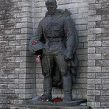
RED ARMY MONUMENT REMOVED FROM TALLINN AMID MOSCOW-ENCOURAGED RIOTS
Publication: Eurasia Daily Monitor Volume: 4 Issue: 83
By:

At 5 am on Friday, April 27, the Soviet-Russian occupation of Estonia ended in a symbolic sense with the removal of the Red Army monument known as the Bronze Soldier from downtown Tallinn. The expected event triggered riots by young local Russian hooligans and drunks of irrelevant ethnicity during the night preceding the removal.
Excavation at the presumed war graves site around the Bronze Soldier was scheduled to begin with an inter-denominational religious ceremony at 10 am on Friday. However, with violent rioting in full swing downtown, the government decided at 3 am during an emergency session to have the monument removed immediately, so as to defuse the potential for more trouble.
Some 1,500 people, mostly local Russians, some of them mobilized by the Nochnoy Dozor (Night Watch) red-brown group, had gathered around the Bronze Soldier in the pre-midnight hours. Some tried unsuccessfully to break through police lines, while most of them rampaged on shopping and residential streets downtown. The rioting received a second wind after the looting of liquor from bars on Tatari Street. Scores were injured, many of them by glass from vandalized shops. One death was reported in a stabbing incident. Thirteen policemen received injuries requiring hospitalization. Some 300 rioters were arrested throughout the night.
The Estonian government had decided in January to relocate the Bronze Soldier as well as any remains of Red Army soldiers that might be found at the site from downtown Tallinn to a military cemetery outside the city. During the intervening months, Russia’s government and television channels instigated local Russians to protest in anticipation of this event. Kremlin and Ministry of Foreign Affairs officials as well as Russian parliamentary leaders accused Estonia of reviving “fascism” and offending Russia as well as local Russians through the intention to remove the Bronze Soldier and, more generally, through the interpretation of World War II and Soviet rule in the Baltics. In Moscow, the pro-Kremlin youth movement Nashi threatened to send scores of its members into Estonia to guard the Bronze Soldier.
Clearly, Moscow calculated that “anti-fascist” protests in Estonia would fit well into Russia’s overall political campaign against the Baltic states on the international level as well as in Russia itself. However, the spree of drunken vandalism that actually ensued in Tallinn will not easily be ennobled by Moscow as “political protest.”
A few remains of Red Army soldiers might be buried at the site where the Bronze Soldier stood until today. The site was not treated as a war grave during the occupation era; indeed, it was and is located at a busy traffic intersection downtown. More recently, Soviet nostalgics sought to re-define the site as a war grave in hopes of staving off its relocation and that of the monument. Indicative of Soviet Russian authorities’ disdain for the lives of their troops, the possible military grave around the monument was not certified or documented.
Estonian authorities offer to treat the Bronze Soldier’s site according to international legal standards by attempting to identify any remains of troops there and re-burying them with honors at the Estonian Defense Ministry’s military cemetery, located on the outskirts of Tallinn. Should any remains of Soviet soldiers be found at the Bronze Soldier’s site (or anywhere else in Tallinn), they would not have died in combat against German troops, but rather against a few Estonian paramilitaries desperately resisting the occupation. The Red Army entered Tallinn three days after the last German troops had withdrawn. During those three days, an Estonian government legally continuous with the pre-war Republic of Estonia exercised authority in Tallinn.
On April 18, Russian Ministry of Foreign Affairs chief spokesman Mikhail Kamynin announced that a protest note had been handed over to the Estonian Embassy in Moscow, warning of “serious consequences for relations between Russia and Estonia” if the Bronze Soldier is relocated from Tallinn. In the evening of April 26, Russia’s Ambassador in Tallinn, Nikolai Uspenski appeared uninvited at the Estonian Ministry of Foreign Affairs to announce that he was “categorically refusing” an earlier Estonian invitation to delegate an embassy observer to the excavation of the site around the Bronze Soldier.
Russian authorities overreacted again on the morrow of the Bronze Soldier’s relocation. High-level officials in Moscow used inflammatory language describing the Estonian authorities’ procedure as “blasphemous” and “mocking the dead.” On April 27, the Federation Council passed unanimously a resolution asking President Vladimir Putin to consider breaking diplomatic relations with Estonia. The Duma International Affairs Committee’s chairman, Konstantin Kosachev, alluded to possible economic sanctions: he is “awaiting decisions by the executive branch, in the first place from those responsible for trade and the economy.” Ultimately, however, Moscow’s reaction is likely to remain confined to rhetoric.
(BNS, Interfax, April 26, 27)




